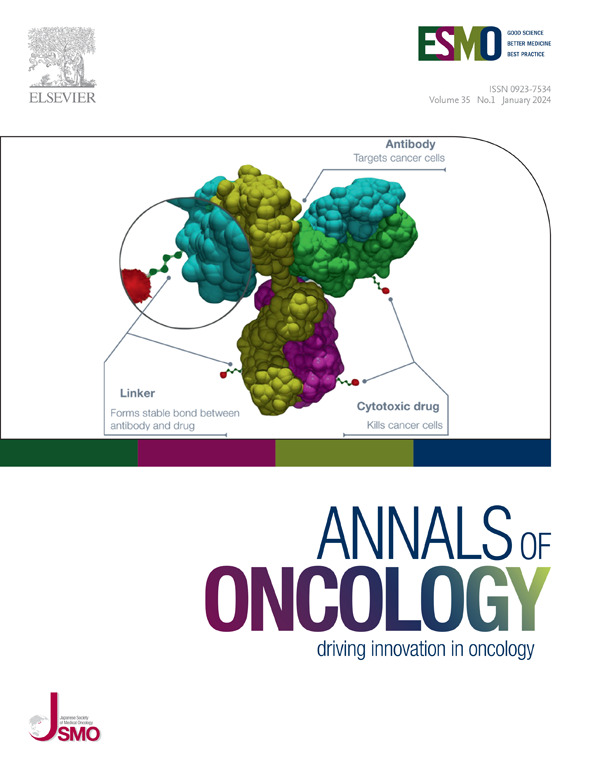A bio-behavioral model of systemic inflammation at breast cancer diagnosis and fatigue of clinical importance 2 years later
IF 65.4
1区 医学
Q1 ONCOLOGY
引用次数: 0
Abstract
Background
We aimed to generate a model of cancer-related fatigue (CRF) of clinical importance 2 years after diagnosis of breast cancer building on clinical and behavioral factors and integrating pre-treatment markers of systemic inflammation.
Patients and methods
Women with stage I-III hormone receptor-positive/human epidermal growth factor receptor 2-negative breast cancer were included from the multimodal, prospective CANTO cohort (NCT01993498). The primary outcome was global CRF of clinical importance [European Organisation for Research and Treatment of Cancer (EORTC) Quality of Life Questionnaire (QLQ)-C30 ≥40/100] 2 years after diagnosis (year 2). Secondary outcomes included physical, emotional, and cognitive CRF (EORTC QLQ-FA12). All pre-treatment candidate variables were assessed at diagnosis, including inflammatory markers [interleukin (IL)-1α, IL-1β, IL-2, IL-4, IL-6, IL-8, IL-10, interferon γ, IL-1 receptor antagonist, tumor necrosis factor-α, and C-reactive protein], and were tested in multivariable logistic regression models implementing multiple imputation and validation by 100-fold bootstrap resampling.
Results
Among 1208 patients, 415 (34.4%) reported global CRF of clinical importance at year 2. High pre-treatment levels of IL-6 (quartile 4 versus 1) were associated with global CRF at year 2 [adjusted odds ratio (aOR): 2.06 (95% confidence interval [CI] 1.40-3.03); P = 0.0002; area under the receiver operating characteristic curve = 0.74]. Patients with high pre-treatment IL-6 had unhealthier behaviors, including being frequently either overweight or obese [62.4%; mean body mass index 28.0 (standard deviation 6.3 kg/m2)] and physically inactive (53.5% did not meet World Health Organization recommendations). Clinical and behavioral associations with CRF at year 2 included pre-treatment CRF [aOR versus no pre-treatment CRF: 3.99 (95% CI 2.81-5.66)], younger age [aOR per 1-year decrement: 1.02 (95% CI 1.01-1.03)], current tobacco smoking [aOR versus never: 1.81 (95% CI 1.26-2.58)], and worse insomnia or pain [aOR per 10-unit increment: 1.08 (95% CI 1.04-1.13), and 1.12 (95% CI 1.04-1.21), respectively]. Secondary analyses indicated additional associations of IL-2 [aOR per log-unit increment: 1.32 (95% CI 1.03-1.70)] and IL-10 [0.73 (95% CI 0.57-0.93)] with global CRF and of C-reactive protein [1.42 (95% CI 1.13-1.78)] with cognitive CRF at year 2. Emotional distress was consistently associated with physical, emotional, and cognitive CRF.
Conclusions
This study proposes a bio-behavioral framework linking pre-treatment systemic inflammation with CRF of clinical importance 2 years later among a large prospective sample of survivors of breast cancer.
乳腺癌诊断时全身炎症的生物行为模型和两年后的临床重要疲劳。
背景:我们的目的是在临床和行为因素的基础上,结合治疗前的全身炎症指标,建立乳腺癌确诊两年后具有临床意义的癌症相关疲劳(CRF)模型:从多模式、前瞻性的 CANTO 队列(NCT01993498)中纳入患有 I-III 期 HR+/HER2- 乳腺癌的妇女。主要结果是确诊两年后(第 2 年)具有临床意义的总体 CRF(EORTC QLQ-C30≥40/100)。次要结果包括身体、情绪和认知 CRF(EORTC QLQ-FA12)。所有治疗前的候选变量都在诊断时进行了评估,包括炎症标志物(白细胞介素[IL]-1a、IL-1b、IL-2、IL-4、IL-6、IL-8、IL-10、γ干扰素、IL-1受体拮抗剂、TNF-α和C反应蛋白),并在多变量逻辑回归模型中进行了检验,该模型采用多重归因,并通过100倍自引导重采样进行验证:在1208名患者中,有415人(34.4%)在第二年报告了具有临床意义的总体CRF。治疗前IL-6水平较高(四分位数4 vs.1)与第2年的总体CRF相关(调整后的比值比[aOR]:2.06 [95%置信区间1.40-3.03];p=0.0002;AUC=0.74)。治疗前IL-6较高的患者有更不健康的行为,包括经常超重或肥胖(62.4%;平均体重指数28.0 [SD 6.3] Kg/m2)和缺乏运动(53.5%不符合世界卫生组织的建议)。与第 2 年 CRF 相关的临床和行为因素包括治疗前 CRF(aOR vs no:3.99 [2.81-5.66])、年龄较小(每 1 年递减:1.02 [1.01-1.03])、目前吸烟(vs never:1.81 [1.26-2.58])以及失眠或疼痛加重(每 10 个单位递增:分别为 1.08 [1.04-1.13]和 1.12 [1.04-1.21])。二次分析表明,在第二年,IL-2(每对数单位增量的 aOR:1.32 [CI 1.03-1.70])和 IL-10(0.73 [0.57-0.93])与总体 CRF 以及 C 反应蛋白(1.42 [1.13-1.78])与认知 CRF 也有关联。情绪困扰始终与身体、情绪和认知CRF相关:本研究提出了一个生物行为框架,将治疗前的全身炎症与两年后大型前瞻性乳腺癌幸存者样本中具有临床意义的 CRF 联系起来。
本文章由计算机程序翻译,如有差异,请以英文原文为准。
求助全文
约1分钟内获得全文
求助全文
来源期刊

Annals of Oncology
医学-肿瘤学
CiteScore
63.90
自引率
1.00%
发文量
3712
审稿时长
2-3 weeks
期刊介绍:
Annals of Oncology, the official journal of the European Society for Medical Oncology and the Japanese Society of Medical Oncology, offers rapid and efficient peer-reviewed publications on innovative cancer treatments and translational research in oncology and precision medicine.
The journal primarily focuses on areas such as systemic anticancer therapy, with a specific emphasis on molecular targeted agents and new immune therapies. We also welcome randomized trials, including negative results, as well as top-level guidelines. Additionally, we encourage submissions in emerging fields that are crucial to personalized medicine, such as molecular pathology, bioinformatics, modern statistics, and biotechnologies. Manuscripts related to radiotherapy, surgery, and pediatrics will be considered if they demonstrate a clear interaction with any of the aforementioned fields or if they present groundbreaking findings.
Our international editorial board comprises renowned experts who are leaders in their respective fields. Through Annals of Oncology, we strive to provide the most effective communication on the dynamic and ever-evolving global oncology landscape.
 求助内容:
求助内容: 应助结果提醒方式:
应助结果提醒方式:


